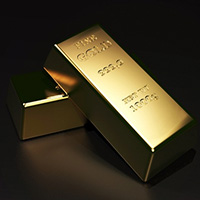A commodity is a basic good that is considered fungible and is used in economic commerce. The fungibility is an important aspect of any commodity since it means that any unit of the commodity is considered as exactly the same as any other one, no matter who the producer was. In addition to being used in the production of material goods and food, commodities can also give investors another way to diversify and to speculate.
Popular commodities
Commodities fall under a number of different categories, which include energies, metals, and agricultural products. Among all of those, by far the most popular commodities are crude oil and gold. There are some other popular commodities, including the ‘sister’ metal to gold, silver. Cocoa and coffee are popular assets among traders as well as other agricultural products, such as grains corn, wheat and soybeans.
Precious metals
The precious metals commodities include the very popular gold and silver. This category also includes the less popular platinum and palladium. And while not a precious metal, copper is often grouped together with these due to its great popularity. Precious metals are very important for traders, as they can serve as a hedge against inflation, uncertainty, upheaval and volatility. Gold is particularly important in this respect and is considered to be a stable and reliable asset. For this reason, gold is often the ‘safe-haven’ of choice during periods of currency devaluation or high inflation.
Energies
The best-known commodity in the energy complex is crude oil, which is traded as both the U.S. benchmark West Texas Intermediate (WTI) crude, and the global benchmark Brent crude. Other energy commodities include heating oil, gasoline, natural gas and liquefied natural gas (LNG). Investors in the energy complex need to be very tuned into the global economy, as shifts in demand for energy can have a dramatic influence on the price. It is also important to keep a watch on OPEC for any changes in production and on technological advances that could replace the need for traditional energy products. One current trend towards electric vehicles has already had a dramatic impact on crude pricing and as the industry grows, could have an even greater impact in the future.
Advantages
Commodity investing comes with a number of positive advantages, including:
- Diversification – Over time the returns from commodities tend to be quite different from the returns provided by other asset classes. This can help lower the overall volatility of your portfolio.
- Leverage – When trading in commodities you can use a substantial amount of leverage in your trades. It is important that you carefully consider the amount of leverage you want to use, as there is a possibility for both increased returns and losses.
- Less manipulation – Because commodity markets are international in scope they are less prone to price fixing and manipulation.
- Hedge against Inflation – While inflation can hurt the value of equities and of cash holdings, commodities tend to increase in value in response to inflationary pressures.
Trading example
One way to trade gold is to use the gold-silver ratio to determine entry and exit points. The gold silver ratio, for those unfamiliar with it, is a measure of the number of ounces of silver it takes to purchase one ounce of gold. So, as an example, if gold is trading at $1,500 and silver is trading at $15 the gold-silver ratio is at 100:1.
It’s interesting to note that historically governments have set this ratio themselves. In the Roman Empire the ratio was set to 12:1 and the U.S. government set a ratio of 15:1 from the late 18th century until the start of the 20th century.
 Trump has declared that the United States could become the global capital of the crypto industry. To achieve this, he proposes reducing regulatory pressures.
Trump has declared that the United States could become the global capital of the crypto industry. To achieve this, he proposes reducing regulatory pressures. Forex trading is a captivating endeavor, promising both active and passive income streams. Yet, mastering forex is a continuous journey that transcends expertise levels, be it a novice or a seasoned trader...
Forex trading is a captivating endeavor, promising both active and passive income streams. Yet, mastering forex is a continuous journey that transcends expertise levels, be it a novice or a seasoned trader... In a resounding victory, NordFX, a prominent brokerage firm, has been crowned the "Best News & Analysis Provider" of 2023...
In a resounding victory, NordFX, a prominent brokerage firm, has been crowned the "Best News & Analysis Provider" of 2023... Errante, the premier online broker, is dedicated to delivering top-tier services and forging long-lasting, trust-based relationships with our clients. Our mission is to enhance your online trading journey...
Errante, the premier online broker, is dedicated to delivering top-tier services and forging long-lasting, trust-based relationships with our clients. Our mission is to enhance your online trading journey... Gold, a precious metal revered for its value for centuries, has found its place in the world of trading. Trading gold has become a popular way to invest in the commodity market...
Gold, a precious metal revered for its value for centuries, has found its place in the world of trading. Trading gold has become a popular way to invest in the commodity market...